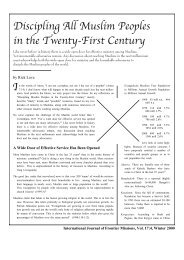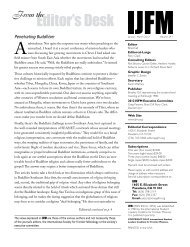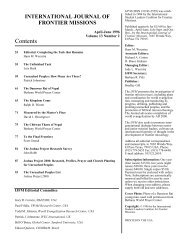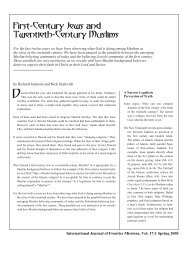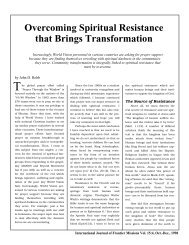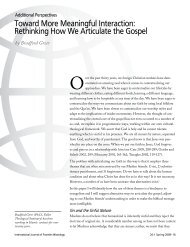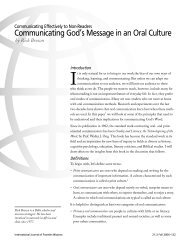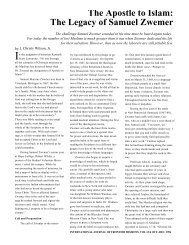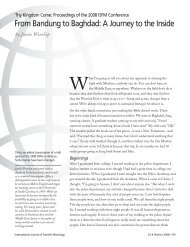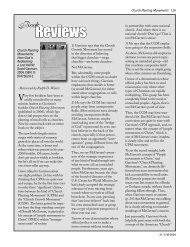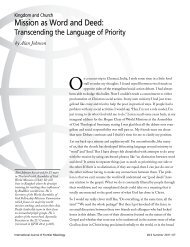Volume 18:2 - International Journal of Frontier Missions
Volume 18:2 - International Journal of Frontier Missions
Volume 18:2 - International Journal of Frontier Missions
You also want an ePaper? Increase the reach of your titles
YUMPU automatically turns print PDFs into web optimized ePapers that Google loves.
76 Field-Governed Mission Structures<br />
Similarly McNeill reports:<br />
By the [sixth century] the Church<br />
<strong>of</strong> Ireland was under the leadership<br />
<strong>of</strong> abbots who were secondarily bishops,<br />
or had bishops attached to their<br />
monasteries and under their jurisdiction<br />
. . . Bishops who are not abbots<br />
appear as agents <strong>of</strong> abbots or <strong>of</strong><br />
monasteries; and bishops in such subordinate<br />
position seem not to have<br />
contended for control. Diocesan episcopacy<br />
did not flourish (McNeil, pp.<br />
69–70).<br />
It is Ralph Winter who sees the<br />
missiological dimension <strong>of</strong> this structural<br />
distinctive:<br />
The Celtic ‘church’ was more a series<br />
<strong>of</strong> missionary compounds than it was<br />
a denomination made up <strong>of</strong> local<br />
churches . . . We must remember the<br />
relative chaos introduced by the invasions,<br />
and therefore not necessarily<br />
expect to see, dotting the landscape,<br />
the usual parish churches that are<br />
familiar in our day (Winter, 1990, p.<br />
B–11).<br />
Celtic peregrini missions were <strong>of</strong>ten<br />
launched by a concept known as “white<br />
martyrdom.” As we have seen above,<br />
St. Patrick desired a martyr’s crown<br />
but did not receive it. Despite repeated<br />
imprisonments and repeated attempts on<br />
Patrick’s life and on the lives <strong>of</strong> his coworkers,<br />
Ireland turned out to be one <strong>of</strong><br />
the few lands in history which was completely<br />
evangelized with no martyrdoms.<br />
Perhaps it was because <strong>of</strong> this that<br />
Patrick’s Celtic successsors developed<br />
the concepts <strong>of</strong> “red martyrdom”, “green<br />
martyrdom” and “white martyrdom.”<br />
“Red martyrdom” refers to what is usually<br />
meant literally by the word “martyrdom.”<br />
“Green martyrdom” refers to a<br />
voluntary vow to withdraw permanently<br />
from human society and to live a radically<br />
ascetic life in some remote location<br />
in the country.<br />
“White martyrdom” refers to a voluntary<br />
vow to leave one’s homeland and<br />
one’s kindred and never to return, never<br />
to see them again, but to spend the<br />
rest <strong>of</strong> one’s life in peregrinatio (“wandering<br />
pilgrimage”), a term Patrick himself<br />
used in the Confessio to describe<br />
his permanent commitment to stay in<br />
Ireland and not to return to Britain.<br />
A person who undertook such a<br />
vow was thus a peregrinus (“wandering<br />
pilgrim”)—another term Patrick used<br />
<strong>International</strong> <strong>Journal</strong> <strong>of</strong> <strong>Frontier</strong> <strong>Missions</strong><br />
for himself; hence the term “peregrini”<br />
to describe the Celtic missionaries who<br />
evangelized Europe.<br />
As with Patrick, so with his peregrini<br />
successors, the commitment to permanent<br />
exile from one’s homeland had an<br />
obvious and direct effect on mission<br />
structures. It is pragmatically impossible<br />
for a base in a home country to exercise<br />
administrative control <strong>of</strong> missionaries<br />
on the field if everyone who leaves<br />
the home country takes a vow never<br />
to return. In the case <strong>of</strong> the Celtic<br />
peregrini, there is no evidence that<br />
their home monasteries in Ireland and<br />
Scotland and England ever attempted<br />
such control.<br />
McNeill writes <strong>of</strong> the early peregrini<br />
missionaries:<br />
They were fond <strong>of</strong> citing the example<br />
<strong>of</strong> Abraham who obeyed the command:<br />
‘Get thee out <strong>of</strong> thy country<br />
and from thy kindred, and from thy<br />
father’s house, to a land that I will<br />
shew thee’ (Gen. 12:1); and this pattern<br />
they followed literally. It was<br />
typical too that in the circumstances<br />
they broke <strong>of</strong>f communication with<br />
their home monasteries. They were not<br />
directed by committees or expected to<br />
make periodic reports to a home base.<br />
The home base was only a prized<br />
memory. With a strange eagerness<br />
they sentenced themselves to perpetual<br />
banishment and went forth<br />
never to return (McNeill, pp. 155–156,<br />
emphasis ours).<br />
To put this in modern terms, the early<br />
Celtic peregrini missions were perhaps<br />
the purest example in history <strong>of</strong> a totally<br />
field-governed structure.<br />
This field governance did not mean that<br />
the missionaries did whatever they felt<br />
like doing, with no accountability. On<br />
the contrary, they had strong, even draconian,<br />
rules for mutual accountability<br />
and authority among the missionaries on<br />
the field. But the fact that decision-making<br />
authority was entirely on the field had<br />
a direct effect on the cultural adaptability<br />
and effectiveness <strong>of</strong> their work:<br />
Complete freedom from superiors<br />
beyond their own communities in the<br />
mission field made them adaptable<br />
to local needs and opportunities.<br />
They rapidly enlisted Frankish and<br />
other German youth who, working<br />
harmoniously with them, made<br />
Christianity indigenous and self-perpetuating<br />
(McNeill, p. 175).<br />
In time, however, the field-governed<br />
structure <strong>of</strong> the peregrini was questioned<br />
from another quarter. In some<br />
<strong>of</strong> the geographical areas the peregrini<br />
entered, the Romanized urban population<br />
had already been somewhat evangelized<br />
in previous centuries before the<br />
massive influx <strong>of</strong> Germanic peoples had<br />
overwhelmed the crumbling remains <strong>of</strong><br />
the Western Roman empire. Some areas<br />
had bishops who tended small urban<br />
churches among the dwindling ethnic<br />
minority <strong>of</strong> Romanized city-dwellers,<br />
while most <strong>of</strong> these bishops apparently<br />
did little for the evangelization <strong>of</strong> the<br />
countryside or <strong>of</strong> the invading tribes.<br />
It was perhaps inevitable that tension<br />
would develop between these bishops<br />
and the Celtic missionaries who arrived<br />
and began to preach to unevangelized<br />
tribes and regions that were technically<br />
located within the dioceses <strong>of</strong> these<br />
bishops.<br />
A good example <strong>of</strong> this tension can<br />
be found in the life <strong>of</strong> Columbanus<br />
(also called Columban). James Thayer<br />
Addison says <strong>of</strong> Columbanus:<br />
The most celebrated <strong>of</strong> all the Irish<br />
who came to the continent in the<br />
early Middle Ages and the great initiator<br />
<strong>of</strong> Irish monastic migration was<br />
Columban (Addison, p. 86).<br />
Gougaud agrees:<br />
To St. Columban above all was due the<br />
initiation <strong>of</strong> these monastic and missionary<br />
migrations to the Continent<br />
(Gougaud, p. 140).<br />
In the early 7th century Columbanus<br />
founded dozens <strong>of</strong> monasteries across<br />
the unevangelized areas <strong>of</strong> what is today<br />
known as France, Germany, Switzerland<br />
and northern Italy. He won many converts<br />
and recruited many new monks<br />
among the local peoples. Many <strong>of</strong><br />
these monasteries grew quite large, their<br />
ranks swelling with local converts, and<br />
they continued to be very influential<br />
throughout the Middle Ages.<br />
Thomas Cahill describes as follows<br />
Columbanus’s tensions with the bishops<br />
in Burgundy:<br />
Before long he clashes with the<br />
region’s bishops who are nettled by<br />
his presence. Still employing the old<br />
Roman episcopal pattern <strong>of</strong> living<br />
urbanely in capital cities and keeping<br />
close ties with those who wear crowns,<br />
the bishops tend their local flocks



